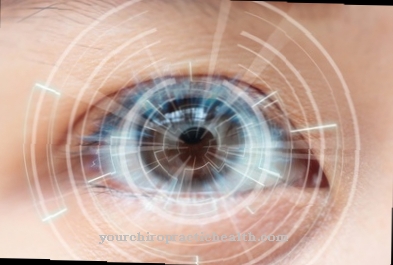The Near fixation is the visual focus on a stimulus in the immediate vicinity. The pit of vision is the retinal point of sharpest vision and is used for fixation. For near fixation, in addition to the visual pit, near accomodation of the eye is required.
What is near fixation?

The fact that humans ideally see things in the distance as clearly as things in the immediate vicinity is due to the ability of the eyes to accommodate. Accommodation is the close-up and distant adjustment that the eyes make by changing the curvature of the lens.
The adjustments are made reflexively by the ciliary muscle. Its state of contraction regulates the tension of the zonular fibers on the lens and thus changes their degree of curvature and refraction. In close accomodation, when looking at nearby objects, the ciliary muscle tenses and allows the zonular fibers to relax. In this way, the lens curves. At the same time, their refractive power increases.
In medicine, near fixation means the targeted observation of an object in the outer space at a short distance. Fixation occurs on the retinal site of the highest resolution (pit of view in Foveola). In physical space, the near fixation is a straight line between the foveola (yellow spot) and an object to be fixed in the immediate vicinity of the viewer. This straight line is also known as the face line.
Function & task
The ciliary muscle is a pair of smooth muscles. When this muscle contracts, the zonular fibers at the opposite end of the lens relax. The inherent elasticity of the lens is thus deflected and the refractive properties change. To see nearby objects, the lens is deformed by the contraction of the ciliary muscle.
The simultaneous occurrence of a convergence movement, a near accommodation and a pupillary constriction is also referred to as a near focus triad and is coupled to one another via a neurophysiological control loop. The extent of the convergence movement is directly related to the accommodation performance.
Like near accomodation, distant accomodation is controlled by the ciliary muscle. When viewing distant objects, the zonular fibers tighten by relaxing the ciliary muscle. In this way, the curvature of the lens and the refractive power of the lens decrease. Through these accommodation processes, humans see objects in the vicinity just as clearly as objects in the distance.
Accommodation also plays a role in fixation. During fixation, the eye rests on a certain visual stimulus of the visual field. The fixation always takes place on a straight line between the visual pit and an object to be fixed. The visual pit is located in the center of the yellow spot and appears there as a depression. This area of the retina is the place of sharpest vision, as is a prerequisite for fixation.
In humans, the visual pit has a diameter of 1.5 millimeters. A receptor cell is located in the visual pit, the signal of which is sent to a single bipolar ganglion cell and from there reaches a single multipolar ganglion cell. There are no transmission losses or signal weakening of the optical information. The signal convergence decreases to approximately 0. Fixation is the main method for conscious vision. The actual acquisition of information about the sense of sight is therefore mostly tied to fixation processes via the pit of vision. All other retinal points or objects outside the line of sight are merely secondary directions.
Fixation is often associated with the concept of visual attention, since the observer focuses on certain objects in the field of vision through fixation. Reading is an example of near fixation. Since reading is about actually gaining information, close-up fixations make up 90 to 95 percent of the total reading time and are therefore the essential visual process when reading.
You can find your medication here
➔ Medicines for visual disturbances and eye problemsIllnesses & ailments
The near fixation of the eye is lost, for example, with a loss of the ability to accommodate. Such a loss can be due to paralysis of the ciliary muscle. In addition to damage to the third cranial nerve (oculomotor nerve), lesions on the optic nerve can also make near fixation impossible. When the oculomotor nerve fails, the eyeball faces outward and downward, and the pupils are dilated. Due to the simultaneous failure of the ciliary muscle, the damaged eye can no longer accommodate movement. In particular, the convergence movements of the near fixation are disturbed. If the second cranial optic nerve fails, the affected eye is completely blind.
If the optic nerve is not completely destroyed, but only the central part at the optic nerve junction is damaged, the patient suffers from heteronymous hemianopia. A contralateral hemianopia results from the destruction of the visual cord. The destruction of the cranial nerves can take place, for example, in the context of neurological diseases such as multiple sclerosis.
The fixation can also be impaired by direct diseases of the visual pit. Such a difficult fixation manifests itself in an eccentric setting or an eccentric fixation. An eccentric setting prevents the use of the visual pit by macular degeneration. The main direction of view is retained. Instead of seeing fixed objects clearly, they are covered by a central scotoma (visual field loss) during fixation. Those affected therefore have to look past objects in order to actually see them.
In the case of an eccentric fixation, unlike the eccentric setting, the viewing pit is no longer the main viewing direction. Another point on the retina has taken over this function and is now used for fixation. This phenomenon occurs, for example, in strabismus disorders and often triggers amblyopia. Subjectively, a person concerned has the impression of directly fixing an object. For fixation, it is based on the new main viewing direction, which henceforth corresponds to the retinal point of eccentric fixation.
A special form of loss of fixation is nystagmiform fixation. It is characterized by an unsteady or restless fixation of objects and is accompanied by eye tremors.













.jpg)

.jpg)
.jpg)











.jpg)